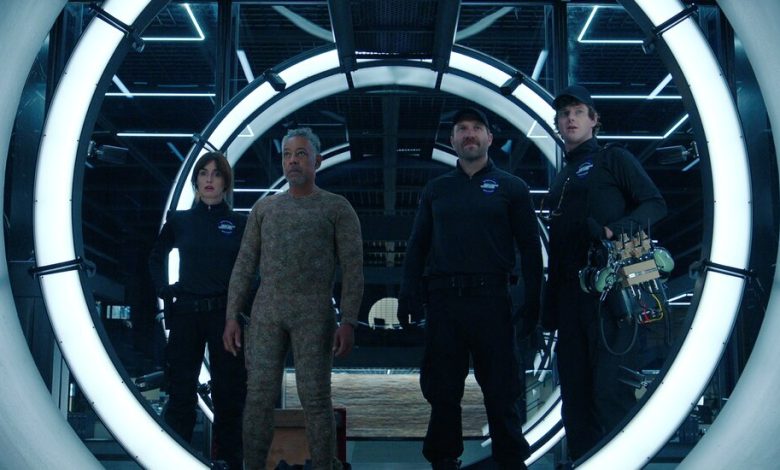Streaming Changed TV. Is TV Changing Streaming Back?

This is not a review of “Kaleidoscope.” One reason for this is that the Netflix heist series, which arrived on Sunday, is not especially noteworthy, except for one gimmick. The other reason has to do with the nature of that gimmick.
The episodes, set before and after an elaborate robbery attempt, are served to Netflix viewers in random order (except for the episode depicting the actual heist, which runs last). So in a way, I can’t review the series as you might see it, because I can’t know which of [tries to summon my knowledge of factorials from middle-school math] a lot of possible permutations you could experience.
That’s the interesting part of “Kaleidoscope.” And let’s be honest, at this point, it’s not that interesting! A few years ago, sure; the series would have seemed like a bold experiment in the ways new technology might change TV.
Now, for much the same reason, “Kaleidoscope” feels like a throwback. It’s one in a series of attempts to use streaming to alter the space-time fabric of television, to make it less linear and in some cases more interactive — many of which have gotten attention, but none of which have really stuck.
Netflix has been the platform most active in these experiments, maybe because it was the most invested in the idea that it was an alternative not only to cable or broadcast networks but also to the genre and business of television itself.
Its 2013 revival of “Arrested Development” was a kind of deconstructed puzzle, its episodes appearing out of chronological order and from different characters’ points of view. Its interactive film/show/game “Black Mirror: Bandersnatch” allowed viewers to choose the path the story followed. So did the “Unbreakable Kimmy Schmidt” special “Kimmy vs. the Reverend”; the animated “Cat Burglar” added a trivia-game element. Netflix was not alone in this either, with Steven Soderbergh going the choose-your-own-adventure route in the HBO series/app “Mosaic.”
After all this, a good decade or so into the streaming revolution, TV today looks — well, it still looks a lot like TV. Attempts at interactivity have gotten no more traction than Smell-o-Vision, maybe in part because our culture already has a popular and relatively young form of interactive amusement, the video game. (One of those, “The Last of Us,” is being adapted by HBO as a conventional TV drama.)
TV’s dominant format continues to be the static season, in which episodes are served up in a set progression. Often — even on streaming — they arrive once a week. The only choosing viewers do is what to watch, when to watch and whether to fill their couch-side snack bowl with chips or pretzels.
In other ways, streaming has absolutely changed the business and aesthetics of TV. As I wrote in 2015, giving viewers the option to binge when they please has encouraged a form of storytelling more focused on the season and less on the episode. Netflix’s philosophy of “the first season is the pilot” — itself an outgrowth of the serial approach of networks like HBO — has led to a more long-game form of narrative, and not only on streaming platforms.
Increasingly, TV series of the past decade have aimed less at hooking viewers from the first minutes than at getting them to sink in, as into quicksand. In an interview with Rolling Stone, Tony Gilroy, the showrunner of the “Star Wars” prequel series “Andor” on Disney+, dismissed “the idea that you have to wrap up every episode in a bow” and defended the series’s slow-burn start as a necessary “investment.” (Granted, it’s easier to get audiences to pony up that investment when you’re selling one of the world’s most famous franchises.)
All this has made a difference for better and for worse. It has added to TV’s bag of tricks, giving creators the option of making more unitary long-form works. (Among other things, the streaming era has been the heyday of the multi-hour limited series.) Other times it imposes the expectation of length where it’s not needed. One thing “Kaleidoscope” has in common with many streaming series is the feeling of being a two-hour movie pitch that was repackaged and padded into a TV season.
The experience of TV, meanwhile, has become less tied to the cable box and the network schedule. A generation of viewers is now used to watching TV at the time, and in the portion size, of its choosing. FX, a pioneer of the High Cable Era of the early aughts, is now as much a boutique subplatform of Hulu as it is a cable channel. There is still a distinction between HBO (the premium channel) and HBO Max (the streamer), but I’m not sure anyone outside the TV business thinks much about it anymore.
Lately, however, it seems as if we’re hitting the limits of how much change TV can handle and how much audiences want. It turns out that TV wants to be linear. Not necessarily in chronology — since the flashbacks and -forwards of “Lost,” TV has become suffused with in media res openings and Vonnegutian unstickings in time. But in almost every case you progress, scene by scene, episode by episode, through a narrative order chosen by a creator, not by you or by the roll of some automated dungeonmaster’s eight-sided die.
Critics of build-your-own-TV experiments often use the restaurant analogy: You want the chef to prepare your dinner; you don’t want to have to cook the ingredients yourself. But that doesn’t mean you want to eat hamburgers every night for the rest of your life. Within that traditional structure — a creative artist deciding what you get, in what order — people are willing to change up the number of courses (episodes) or opt for a family-style experience in which the entire meal (season) arrives to the table at once.
This flexibility goes both ways. As more streaming competitors have come online, some have opted for a more, well, TV-like release schedule. Apple is fond of introducing series with a few episodes, then releasing one a week. Disney favors a one-at-a-time, tune-in-next-week pattern for its tent-pole Marvel and Star Wars series. Even Amazon, which once mirrored Netflix in dropping its seasons all at once, went with a weekly schedule for its mithril-plated Tolkien series, “The Lord of the Rings: The Rings of Power.”
There’s a certain school of TV fan and critic — call them the episodicists — who will hail these changes as proof that the old ways are the right ways. TV needs tightly constructed individual episodes, goes the argument, and the audience craves the communal experience of tuning in at the same bat-time to the same bat-channel (or -platform).
I think something more nuanced is going on: Decision by decision, TV is collectively feeling its way toward figuring out which viewing experience works best for which kind of series. As the critic Kathryn VanArendonk wrote in Vulture, a well-crafted TV season is not simply “a ten-hour movie.” But neither does every show in 2023 need to be structured and experienced like “Dragnet.”
Some shows benefit from the giddy feeling of unwrapping a new present every week. “Game of Thrones,” though its episodes only occasionally focused on single stories, might not have become as big a phenomenon without the weekly hype cycle.
On the other hand, FX on Hulu’s “The Bear,” whose entire season dropped at once last summer, prompted more buzz and discourse than many of FX’s weekly series. It may be that this kind of dramedy — character-based, relatively short, not driven by big plot detonations — is better taken in one gulp.
Elsewhere in streaming, TV-like practices seem to be returning out of the sheer dollars-and-cents realization that the business is not limitless.
Netflix has gone from saving canceled shows to axing series like “1899” after a single season, like an old-time broadcaster with an itchy trigger finger. As for streaming as an infinite video library — well, it’s looking more finite, with titles like “Westworld” pulled from circulation to cut costs, in a return to the pre-VCR days when a canceled show simply vanished into memory.
For now, at least, streaming and TV seem to be meeting in a still-coalescing middle, with elements of media’s future and its past. The talent is still flowing to streaming; the director Rian Johnson (“Knives Out”), for instance, is about to premiere his first series, “Poker Face,” on Peacock. But rather than a mind-melting narrative experiment in the mold of his movie “Looper,” it is a case-of-the-week detective story, à la NBC in the 1970s.
As for Netflix, amid recent signs that it can’t keep growing explosively forever, it has introduced something that used to be anathema to it: a subscription tier with ads. A decade ago, Netflix defined our current conception of streaming. Its next phase may involve turning itself into TV.




